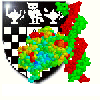Self Assessment Questions
These questions can be answered in less than 100 words. Please
Email you
group tutor with you answers before Monday 16th March.
- Define the term "hydrophobicity" (when used in relation to amino acids
and proteins)
- Why is the amino acid proline often referred to as a "helix breaker"?
- What are the principles underlying amino acid residue side chain
conformations in proteins?
- What information, other than the amino acid sequence itself, is
available in a SwissProt entry?
- Which databases on the Internet would you use to find protein sequence
patterns associated with specific functions?
- Describe a program or technique which can be used to represent a
protein structure within a page of HTML.
- Discuss briefly the four building blocks that form DNA and the way
these are assembled to form a double helix.
- Indicate the different roles within the cell of rRNA, tRNA and mRNA.
- What is the structure of the lac operon and indicate how it is
regulated.
- What are Signal Recognition Particles?
- How do the four bases in mRNA code for twenty amino acids and
control initiation/termination during translation?
- Why are glycine residues often conserved in homologous protein
sequences?
- Give the phi/psi torsion angle limits for right-handed alpha-helices,
beta-strands and left-handed helices.
- Why are cations often bound to the C-terminal of alpha-helices?
- Give three reasons why the substitution of an Asp(D) by a Trp(W) in a
protein sequence is unlikely.
- Which type of interaction, H-bonding, hydrophobic interactions or
ionic interactions, is likely to be the most important in energy terms
in causing protein molecules in dilute aqueous solution to associate
with each other? Why?
- Why is the pKa of the epsilon-amino group higher than that of the
alpha-amino group of Lys?
- Which of the following amino acids are likely to be found in the
interior of a protein and which on the exterior: Val, Pro, Phe, Asp,
Lys, His, Gly.
- Histones have high percentages of basic (Arg and Lys) amino acids.
Will it be easy to determine their sequences by peptide mapping? Why
or why not?
- Two of the twenty amino acid residues which occur in proteins have
side groups which contain asymmetric carbons. Which are they and what
is the R/S classification of each asymmetric centre?

